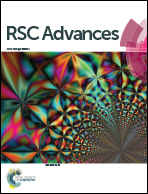Design of a meso-structured Pd/NiO catalyst for highly efficient low temperature CO oxidation under ambient conditions†
Abstract
A meso-structured Pd/NiO catalyst was successfully fabricated through a controlled pyrolysis and in situ reduction protocol. The resulting material possessed a relatively high surface area and highly dispersed palladium species. It showed much higher catalytic activity and stability for CO oxidation under ambient conditions. Complete CO conversion could be achieved at as low as −20 °C, when 1.2 vol% H2O was introduced into the feed gas. The catalyst exhibited no detectable deactivation even after 100 hours of reaction. The extraordinary catalytic activity and durability were attributed to the promotion of the water molecules and the synergetic effect between the Pd nanoparticles and meso-structured NiO support.


 Please wait while we load your content...
Please wait while we load your content...